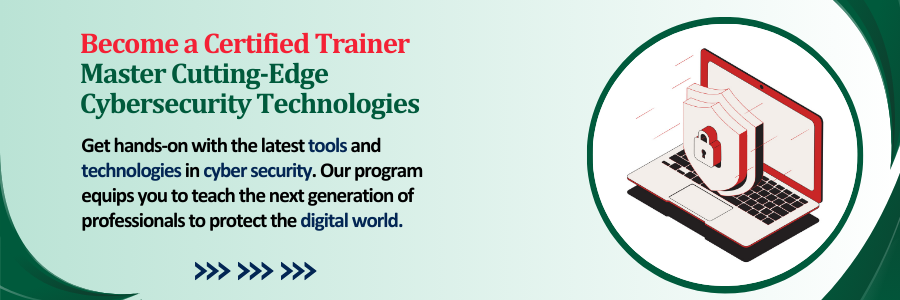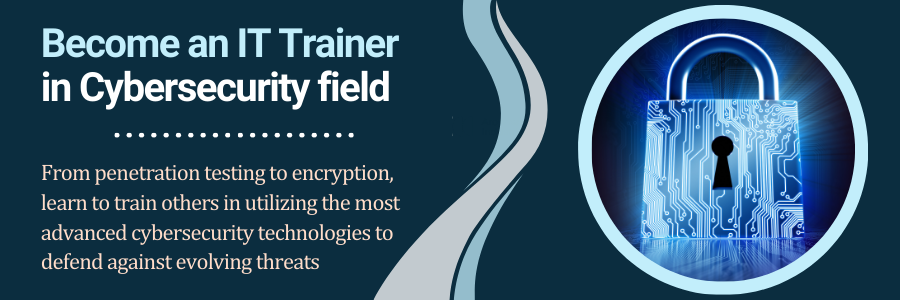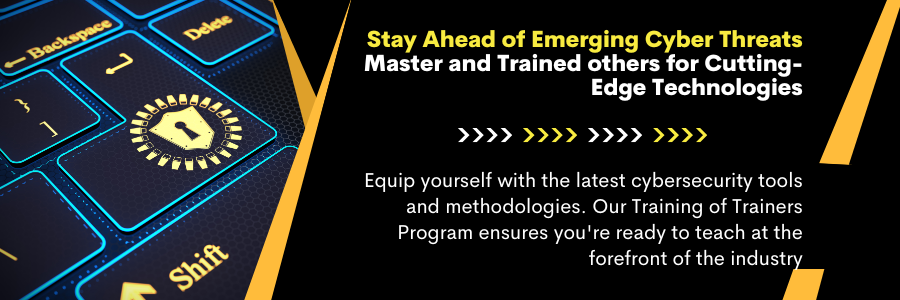



Training of IT Trainer in Cyber Security
The purpose of offering a structured four-year training program is to develop a highly competent, proficient, and dynamic cadre of IT trainers in the field of cybersecurity. The program is designed to ensure that trainers are not only technically skilled but also capable of effectively transferring their knowledge to others, contributing to the growth and resilience of the cybersecurity workforce.
This comprehensive program aims to:
- Build a Deep Knowledge Base: Provide trainers with an extensive, layered understanding of cybersecurity from the fundamentals to advanced leadership skills, ensuring they can train others at various levels of expertise.
- Create Cybersecurity Leaders: Develop trainers who can lead cybersecurity initiatives, impart cutting-edge knowledge, and effectively combat evolving cyber threats.
- Enhance National Cyber Resilience: By creating a well-trained group of cybersecurity experts, the program contributes to strengthening national and organizational cyber defenses, protecting critical infrastructure, and securing sensitive information.
- Foster Lifelong Learning: Equip trainers with the mindset and skills for continuous learning, ensuring they stay ahead of emerging threats and technologies in the rapidly evolving field of cybersecurity.
Program Intention
The intention of this four-year program is to produce cybersecurity trainers who can elevate the standards of cybersecurity education and training across industries, academia, and government sectors. By systematically progressing through four levels, the program ensures that trainers develop a solid foundation and gradually build up to advanced expertise and leadership capabilities.
The program is intentionally designed to:
- Develop a Well-Rounded Skill Set: Trainers gain both breadth and depth in cybersecurity knowledge, enabling them to address diverse topics from basic cyber hygiene to advanced security architecture.
- Inculcate Teaching Excellence: Foster excellence in instructional methods so that trainers can effectively disseminate knowledge and train others with clarity, confidence, and innovation.
- Encourage Ethical Leadership: Equip trainers with ethical values and leadership skills, enabling them to inspire and mentor future generations of cybersecurity professionals while upholding the highest standards of integrity.
- Promote Collaboration: Encourage collaboration between industry, academia, and government, creating a cohesive ecosystem of cybersecurity education and training.
Program Objective
This four-year program is a transformative journey that not only prepares individuals to excel in the field of cybersecurity but also positions them as key drivers of cybersecurity education and training, capable of creating a significant impact on the cybersecurity landscape.
- To Develop Multi-Tier Expertise: Ensure that trainers acquire a comprehensive skill set across various levels of cybersecurity, starting from the basics at O-Level to advanced strategy and leadership at C-Level, enabling them to train individuals at different stages of their learning journey.
- To Build Instructional Excellence: Cultivate strong teaching capabilities, enabling trainers to design and deliver effective cybersecurity training programs that cater to a wide range of learners, from beginners to advanced professionals.
3. To Equip Trainers with Practical Experience: Provide hands-on experience through real-world simulations, case studies, and projects, ensuring that trainers can teach both theoretical knowledge and practical skills that are directly applicable in the cybersecurity field.
4. To Foster Ethical and Responsible Practices: Instill strong ethical foundations and responsible cybersecurity practices in trainers, ensuring that they promote and teach cybersecurity with a focus on legal compliance, ethics, and societal responsibility.
5. To Create Cybersecurity Leaders: Develop trainers who are capable of leading cybersecurity training initiatives, shaping curricula, influencing policy, and making strategic decisions to strengthen cybersecurity at organizational and national levels.
6. To Enhance Career Prospects for Trainers: Equip trainers with a recognized and rigorous credential that enhances their career opportunities, opening doors to leadership roles in education, corporate training, government agencies, and consulting.
7. To Strengthen National and Organizational Cybersecurity: Contribute to the national agenda of creating a robust cybersecurity workforce, reducing cyber threats, and ensuring the safety and security of critical infrastructure and sensitive data through the development of highly trained cybersecurity professionals.
Training of Information Technology Trainer's Program
Here is the breakdown of the four levels (O-Level, A-Level, B-Level and C-Level) divided into four quarters, with each quarter focusing on specific topics. This will provide a structured learning pathway at each level.
O-Level: Entry-Level Training
The purpose of the O-Level is to empower participants with essential cybersecurity knowledge, helping them understand the fundamental principles of online safety, networking, and ethical hacking. This level serves as the entry point for individuals with limited or no prior experience, aiming to cultivate a solid understanding of basic cybersecurity concepts, legal frameworks, and hands-on defensive measures. The ultimate goal is to prepare learners for more advanced training in subsequent levels by ensuring they have a strong foundational grasp of the subject.
01 Quarter - Cyber Start
The purpose of "Cyber Start" is to introduce participants to the fundamental concepts of cybersecurity and digital literacy. The intention is to build a strong foundation by familiarizing learners with basic cybersecurity practices, including safe internet usage, cyber hygiene, and the core principles of protecting digital information. This quarter aims to spark interest and confidence in cybersecurity by providing essential knowledge to beginners.
Quarter 1: Cybersecurity Basics
- Introduction to Cybersecurity
- Concepts of Cybersecurity
- Cyber Threats and Vulnerabilities
- Digital Literacy
- Safe Internet Usage
- Basic Cyber Hygiene Practices
02 Quarter - NetSafe Foundations
NetSafe Foundations is designed to deepen participants' understanding of networking fundamentals and basic network security concepts. The intention is to equip learners with the knowledge to understand how networks operate and the importance of securing them. This quarter serves as a critical building block in understanding how data moves across networks and how to protect it from cyber threats.
Quarter 2: Networking Fundamentals
- Fundamentals of Networking
- Introduction to Networking and Internet Protocols
- Basic Network Security
- Introduction to Ethical Hacking
- Ethical Hacking Concepts and Tools
- Basic Reconnaissance Techniques
03 Quarter - LawShield
The purpose of LawShield is to introduce participants to the basics of cyber law and the legal framework surrounding cybersecurity. The intention is to provide learners with an understanding of the legal responsibilities and implications of cyber activities, helping them comprehend the importance of compliance and ethical conduct in the digital space. This quarter emphasizes the role of law in maintaining cybersecurity.
Quarter 3: Cyber Law and Incident Response
- Cyber Law Basics
- Overview of Cyber Laws
- Legal Aspects of Cybersecurity
- Basic Incident Response
- Incident Response Fundamentals
- Initial Response to Cyber Incidents
04 Quarter - Secure Hands-On
Secure Hands-On focuses on applying the knowledge gained in previous quarters through practical lab sessions and projects. The intention is to provide learners with hands-on experience in implementing cybersecurity measures and defending basic networks. By working on real-world scenarios, participants solidify their understanding and gain confidence in their ability to secure digital environments.
Quarter 4: Final Projects and Hands-On Practice
- Practical Lab Sessions
- Implementing Cybersecurity Measures
- Basic Network Security Setup
- Capstone Project
- Real-World Scenario: Defend a Simple Network
A-Level: Intermediate Training
The purpose of the A-Level is to prepare participants for more complex cybersecurity tasks and responsibilities by building on the foundational knowledge gained at the O-Level. It aims to develop intermediate skills that are critical for roles such as network security professionals, ethical hackers, and digital forensics analysts. The A-Level is designed to bridge the gap between basic understanding and advanced practice, making participants proficient in practical applications of cybersecurity tools and techniques. It also ensures they are aware of the evolving legal and ethical considerations in cybersecurity.
01 Quarter - CyberAdvance
The purpose of CyberAdvance is to take participants deeper into advanced cybersecurity practices, focusing on threat intelligence, security operations, and network security essentials. The intention is to elevate learners’ knowledge from basic to intermediate, providing them with the skills needed to handle more complex cybersecurity challenges and implement stronger defenses.
Quarter 1: Advanced Cybersecurity Practices
- Advanced Cybersecurity Techniques
- Threat Intelligence and Mitigation
- Security Operations
- Network Security Essentials
- Firewalls and VPNs
- Wireless Security Protocols
02 Quarter - HackLab
HackLab is designed to provide participants with practical skills in ethical hacking and penetration testing. The intention is to train learners to think like attackers so they can better defend against cyber threats. This quarter focuses on hands-on learning and the practical application of hacking tools and techniques, preparing participants for real-world cybersecurity assessments.
Quarter 2: Penetration Testing and Digital Forensics
- Ethical Hacking and Penetration Testing
- Vulnerability Assessments
- Exploitation Techniques
- Introduction to Digital Forensics
- Forensic Analysis Tools
- Evidence Collection Methods
03 Quarter - LawGuard
The purpose of LawGuard is to expand participants' knowledge of cyber law, with a focus on data protection regulations and legal considerations in cybersecurity. The intention is to ensure that learners are well-versed in legal requirements and ethical standards, enabling them to navigate the legal complexities of cybersecurity while maintaining compliance and promoting ethical practices.
Quarter 3: Cyber Law and Cloud Security
- Advanced Cyber Law
- In-Depth Study of Cybercrime Cases
- Data Protection Laws
- Cloud Security Fundamentals
- Securing Cloud Environments
- Cloud Computing Risks and Mitigations
04 Quarter - CloudGuard
CloudGuard aims to introduce participants to cloud security fundamentals and the risks associated with cloud computing. The intention is to provide learners with the knowledge and skills to secure cloud environments, which are increasingly becoming central to modern IT infrastructure. This quarter emphasizes best practices for safeguarding data and applications in the cloud.
Quarter 4: Final Projects and Hands-On Practice
- Practical Lab Sessions
- Simulated Penetration Testing Exercises
- Forensics Case Study Analysis
- Capstone Project
- Real-World Scenario: Securing a Small Business Network
B-Level: Advanced Training
The purpose of the B-Level is to develop participants into experts capable of handling sophisticated cybersecurity operations and leading advanced defensive and offensive efforts. It provides in-depth training in specialized areas such as cryptography, blockchain security, and proactive threat hunting, equipping participants to take on roles like senior cybersecurity analysts, security architects, and incident response leaders. This level is designed to cultivate a deep technical understanding of advanced cybersecurity practices, with a strong emphasis on hands-on experience and strategic thinking, ensuring that participants can confidently secure and defend large-scale systems.
01 Quarter - PowerTest
The purpose of PowerTest is to advance participants' penetration testing skills by introducing them to sophisticated exploitation techniques and offensive security practices. The intention is to produce cybersecurity professionals who can lead advanced penetration testing initiatives, helping organizations proactively identify and mitigate vulnerabilities in their systems.
Quarter 1: Advanced Penetration Testing
- Exploitation Techniques
- Advanced Hacking Tools and Methods
- Red Team/Blue Team Exercises
- Security Architecture and Design
- Designing Secure Systems
- Enterprise Security Planning
02 Quarter - ForensicPro
ForensicPro focuses on developing advanced skills in digital forensics and incident response. The intention is to train participants to handle complex digital investigations and respond effectively to cyber incidents. By mastering forensic tools and techniques, learners will be able to analyze cyberattacks and gather evidence in a legally sound manner, helping to protect and recover compromised systems.
Quarter 2: Digital Forensics and Incident Response
- Advanced Digital Forensics
- In-Depth Forensics Analysis
- Legal and Ethical Considerations
- Incident Response Strategies
- Proactive Threat Hunting
- Post-Incident Analysis and Reporting
03 Quarter - CryptoMind
The purpose of CryptoMind is to deepen participants' understanding of cryptography and its applications in blockchain security. The intention is to equip learners with advanced knowledge of encryption techniques and how they are used to secure modern technologies like blockchain. This quarter prepares participants to design and implement cryptographic solutions to protect sensitive data and transactions.
Quarter 3: Cryptography and Threat Intelligence
- Cryptography and Blockchain Security
- Encryption and Decryption Techniques
- Blockchain Technology and Security
- Threat Hunting and Intelligence
- Proactive Threat Intelligence
- Cyber Threat Landscape and Analysis
04 Quarter - CyberMaster
CyberMaster is designed to consolidate all the advanced skills learned throughout the B-Level by engaging participants in hands-on projects and simulations. The intention is to ensure that learners can apply their expertise in real-world cybersecurity scenarios, from threat hunting to building secure architectures. This quarter aims to produce cybersecurity masters ready to take on complex challenges in the field.
Quarter 4: Final Projects and Hands-On Practice
- Practical Lab Sessions
- Real-World Forensics and Incident Response Scenarios
- Threat Hunting Simulations
- Capstone Project
- Real-World Scenario: Designing and Implementing Security for an Enterprise System
C-Level: Expert-Level Training
The purpose of the C-Level is to produce expert-level professionals who are not only technically proficient but also capable of leading cybersecurity efforts at an organizational or national level. This level focuses on developing leadership qualities, strategic planning skills, and a deep understanding of global cybersecurity dynamics, including cyber warfare and national defense strategies. Participants are trained to design, implement, and manage comprehensive security strategies, ensuring the resilience and security of critical infrastructure and large organizations. The C-Level aims to prepare participants for top-tier roles such as Chief Information Security Officer (CISO), cybersecurity strategist, and policy advisor, equipping them to shape the future of cybersecurity in their respective domains.
01 Quarter - CyberLead
The purpose of CyberLead is to prepare participants for leadership roles in cybersecurity by focusing on strategic planning, decision-making, and leading cybersecurity teams. The intention is to develop cybersecurity leaders who can drive organizational security initiatives, make informed strategic decisions, and lead teams in the defense against cyber threats at a high level.
Quarter 1: Cybersecurity Leadership and Strategy
- Cybersecurity Leadership
- Strategic Planning for Cybersecurity
- Leading Cybersecurity Teams
- Advanced Security Architecture
- Secure System Design and Architecture
- Security at Scale for Large Enterprises
02 Quarter - SecureGov
SecureGov aims to train participants in governance, risk, and compliance (GRC) practices, with a focus on creating and implementing security policies that align with regulatory standards. The intention is to produce experts who can lead cybersecurity governance initiatives, ensuring that organizations meet compliance requirements and manage risks effectively. This quarter prepares participants to oversee the security posture of large enterprises.
Quarter 2: Governance, Risk, and Compliance (GRC)
- Governance and Compliance
- Creating and Implementing Security Policies
- Compliance Standards (ISO, NIST, GDPR)
- Risk Management
- Identifying and Mitigating Cyber Risks
- Security Audits and Assessments
03 Quarter - WarDefend
The purpose of WarDefend is to prepare participants for the complexities of cyber warfare and defense strategies. The intention is to train cybersecurity leaders who can understand and respond to national and global cyber threats, including cyber warfare tactics and defense mechanisms. This quarter equips learners to play a critical role in defending national infrastructure and responding to large-scale cyber incidents.
Quarter 3: Cyber Warfare and Defense
- Cyber Warfare Tactics
- Understanding Cyber Warfare Techniques
- National and Global Defense Strategies
- Advanced Incident Response
- Coordinating Large-Scale Incident Responses
- Global Incident Handling and Reporting
04 Quarter - Strategic Shield
Strategic Shield focuses on consolidating expert-level knowledge and skills by engaging participants in large-scale cybersecurity strategy development and defense simulations. The intention is to prepare participants to design and implement comprehensive cybersecurity strategies for national or organizational defense. This quarter ensures that learners are fully equipped to take on leadership roles and manage high-stakes cybersecurity challenges at the highest level.
Quarter 4: Final Projects and Hands-On Practice
- Practical Lab Sessions
- Developing a Comprehensive Cybersecurity Strategy
- Coordinating a Large-Scale Cyber Defense Simulation
- Capstone Project
- Real-World Scenario: Designing a Cyber Defense Strategy for a National-Level Organization.
